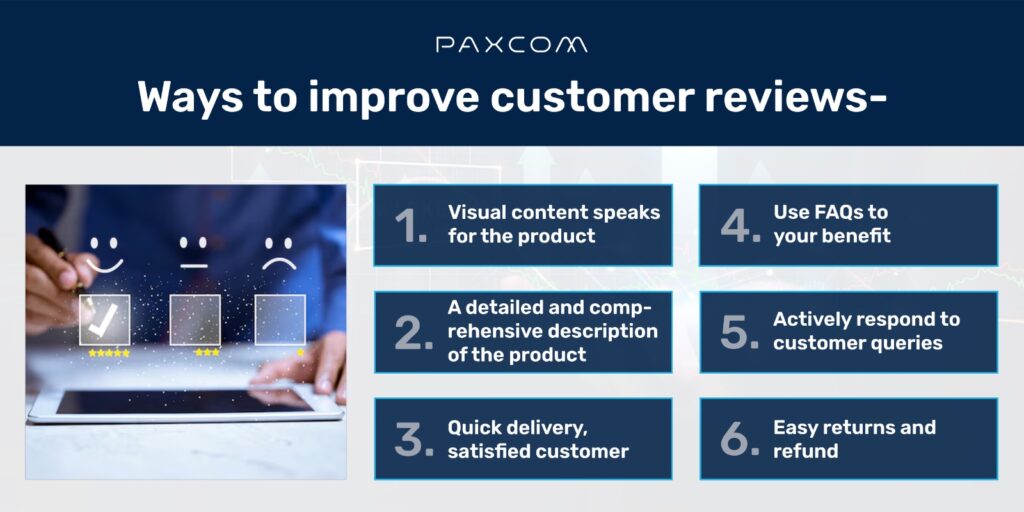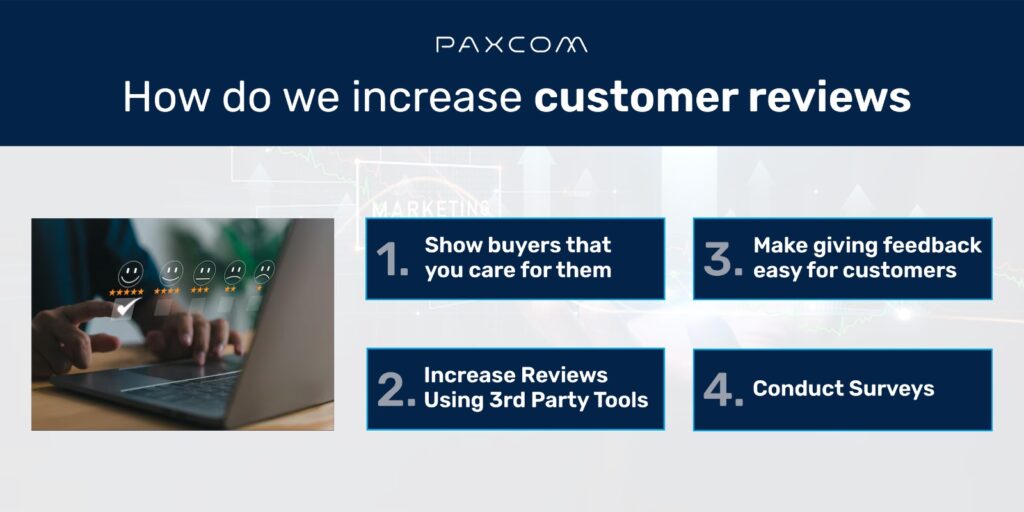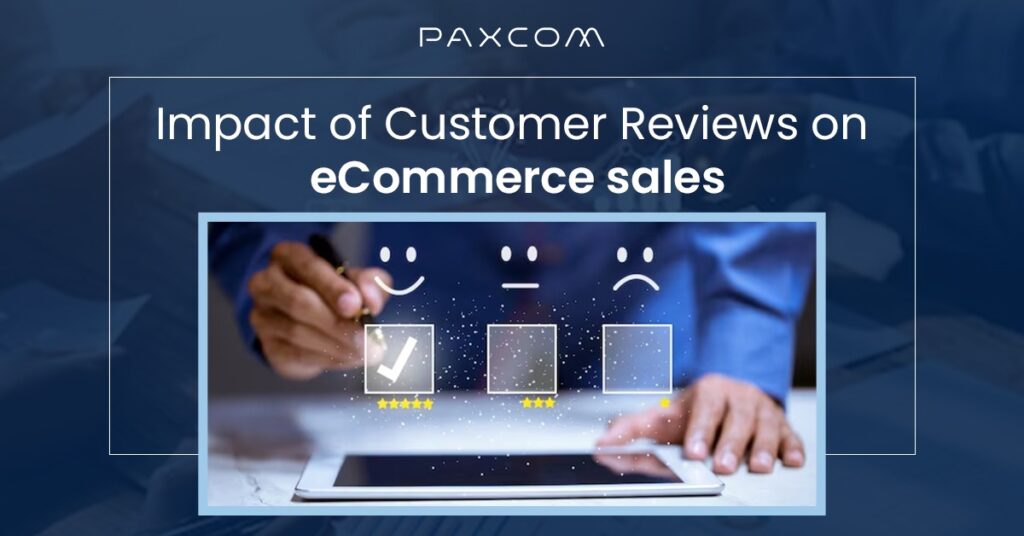Imagine this scenario: You’re on the hunt for a new smartphone, sifting through numerous options online. As you peruse product descriptions and scan images, a trend emerges – you’re drawn to products boasting glowing five-star ratings and positive feedback from fellow shoppers.
With the exponential rise of online shopping and the growing importance of social proof, customer reviews wield considerable influence over our purchasing decisions and the overall prosperity of e-commerce.
Now, why start a blog with an example of a review? This is because, in this blog, we will discuss how impactful e-commerce reviews are for a brand and what the key takeaways from them should be.
The Impact of Customer Reviews on Buying Choices
When it comes to online shopping, customer reviews wield substantial influence over purchase decisions. Studies reveal that many consumers actively seek out and consider reviews before purchasing. Let’s explore the key ways in which these reviews shape buying decisions:
- Product Information and Validation: Reviews serve as a valuable source of detailed product information, helping customers assess features, benefits, and potential drawbacks. They provide validation, assisting customers to determine if a product aligns with their needs and expectations.
- Rating and Overall Reputation: Customer reviews show that a product’s collective rating and reputation heavily influence consumer choices. Products with high ratings and positive feedback tend to attract more attention, signaling quality and reliability to potential buyers.
- User Experience: Shoppers rely on the firsthand experiences shared by other customers to gauge whether a product suits their individual preferences and requirements. Positive reviews highlighting a satisfying user experience often sway purchase decisions in favor of the praised product.
- Comparative Analysis: Reviews offer a platform for customers to compare different products and brands. They provide insights into how a product stacks up against its competitors, aiding shoppers in making well-informed decisions.
Most impactful reviews are detailed and honest, mention product features (good and bad), and explain the user’s experience with the product.
Earlier, only giants like Amazon gave their customers the benefit of leaving feedback. Almost every e-commerce business has a review section; a recent entry to this is Bigbasket. In the era of e-commerce, reviews are the customers’ voice, and they use them to show their happiness and discontent with a product or service. According to research conducted by Power Reviews, 95% of shoppers read online reviews before making a purchase, and 86% consider them an essential resource when making buying decisions. Therefore, a piece of advice for e-commerce businesses will be to take them seriously, as they can define sales volumes for your products.
Table of Contents
What are Product Reviews?
Product reviews are user-generated content. Organic reviews speak to the minds of consumers, and they can be candid about the qualities and drawbacks of a product.
For browsers or potential shoppers, the reviews help determine if the product fits their requirements.
Both big and small brands, as well as giant e-commerce platforms like Amazon, Walmart, etc., acknowledge that analyzing them can be a great customer listening tool. They are therefore highly considerate about meticulously examining them.
Amazon, in particular, separates verified reviews from unverified ones. Let’s discuss them in detail:
Verified Review: Amazon gives a ‘Verified Purchase’ badge to ensure that the person writing the review has purchased the product and did not receive any heavy discount in return.

Unverified Reviews: If the buyer did not make the purchase through Amazon or at a heavily discounted price, Amazon marks the review as unverified. Amazon also declares them unvalidated when received instead of providing an incentive to the buyer.

*The above definitions are from Amazon
The ‘Verified Purchase’ badge can improve purchases by 15%, according to AMZ Advisers. Hence, Amazon gives excellent value to authenticating a review before posting it. These reviews are mostly placed above unverified reviews and impact purchases the most.
Why are product reviews important?
Product reviews have become a cornerstone of consumer decision-making in today’s digital age. Whether purchasing a new gadget, booking a hotel, or trying out a new restaurant, we often turn to online reviews to guide our choices. But why exactly are product reviews so crucial? Let’s delve into the key reasons behind their importance.
Online Reviews: The Power of Crowd Wisdom
Online reviews provide a window into the experiences of real consumers. They offer valuable insights into product quality, functionality, and overall satisfaction. By reading reviews from fellow shoppers, prospective buyers can better understand what to expect from a product before making a purchase. Whether a detailed analysis or a brief comment, each review contributes to the crowd’s collective wisdom.
User Testimonials: Trust and Transparency
User testimonials serve as authentic endorsements of a product or service. Positive testimonials from satisfied customers build trust and credibility, reassuring potential buyers that they’re making a wise choice. Conversely, negative testimonials highlight areas for improvement, prompting businesses to take corrective action and enhance their offerings. By sharing their experiences, users contribute to a culture of transparency and accountability in the marketplace.
Review Management: Engaging with Feedback
Effective review management involves actively engaging with customer feedback. Businesses that respond promptly—both positive and negative reviews—demonstrate a commitment to customer satisfaction. Companies can foster positive customer relationships by addressing concerns, resolving issues, and expressing gratitude for positive feedback. Review management isn’t just about monitoring feedback; it’s about actively participating in the conversation and showing customers that their opinions matter.
Reputation Management: Shaping Brand Perception
Reputation management is essential for safeguarding brand image and credibility. Positive reviews bolster a company’s reputation, attracting customers and driving sales. On the other hand, negative reviews can damage a brand’s reputation and deter potential buyers. Proactive reputation management strategies involve soliciting positive reviews, addressing negative feedback constructively, and actively monitoring online sentiment. Effective reputation management enables businesses to shape consumer perception and uphold a positive brand image.
Review Aggregation: Making Informed Decisions
Review aggregation platforms compile reviews from various sources, providing consumers with a comprehensive overview of a product’s reputation. These platforms gather reviews from multiple websites and platforms, allowing users to compare ratings and make informed decisions. For businesses, review aggregation offers valuable insights into customer sentiment and helps identify areas for improvement. By leveraging review aggregation tools, companies can stay informed about what customers say and adapt their strategies accordingly.
Builds a relationship of trust
Unlike a physical store, e-commerce sites do not have an assistant to ask questions about the product. Since they can only touch or feel it after buying, they only have the information and images to rely on and assess the looks and quality. Allowing buyers to share their thoughts about the product and providing them with rich content helps build trust with them. Equally important is to act upon the positive or negative review to maintain this trust.
Boosts SEO
Most businesses think that for successful SEO, they need only keyword-optimized, rich content in the form of articles, blogs, infographics, PPT vlogs, etc. to rank higher on the search engine result page. However, user-generated content like reviews breaks this myth. When buyers post a review on your e-commerce website, they give search engines rich, authentic, keyword-optimized content, food for Google, and search engines of Amazon and other e-commerce channels to increase product rankings.
Now you know the importance of reviews for your business. Consider the buyer magnets. The more you gather them, the greater your chances of stepping above your competitors. You also need to learn a few tricks to improve reviews to get a stronghold of the market share you aim for. Let’s get into the details:
Ways to improve customer reviews?

Visual content speaks for the product
On an e-commerce website, buyers rely on the product images and those posted by other buyers to understand how the product looks. As per Power Reviews, 88% of shoppers rely solely on images others share before purchasing to see how the product looks. Therefore, you should create visually appealing content like high-pixel images, videos, and 360-degree views in line with the product so they do not mislead. This increases customer satisfaction, which motivates them to leave a positive review and helps you build your brand value.
As per our internal study, one of our clients in the healthcare category was facing negative feedback about incorrect readings in one of their products. This was because customers needed to set up the machine correctly. We clearly highlighted the steps of setup in their content, which helped them reduce the negative reviews on this issue.
A detailed and comprehensive description of the product
You indeed want to describe your product as the best among your competitors, but there are better practices than misleading your buyer. A detailed product description and a comprehensive title are essential for increasing the conversation rate, but your conversion can dip faster than you think if your product details do not justify its quality when it reaches your buyer. Additionally, be prepared to be a bystander to a trail of negative feedback. If you want to prevent it from happening, write a description that genuinely matches your product. It is a conviction for buyers and a consolation that they are not being ditched. The end re will be a stream of happy reviews.
A too-good-to-be-true digital content can lead to negative reviews if the customer feels the actual product doesn’t match the content highlighted by the brand.
Use FAQs to your benefit
Unanswered questions about a product can delay a purchase. Be proactive, consider what your customer might need an answer for before buying the product, and create detailed FAQs while optimizing your content. When buyers’ thirst for information is satisfied, your sales will likely increase significantly. The FAQs are a great way to maximise the user experience. They can increase the conversion rate by 157.1%. Therefore, having a section dedicated to it positively impacts buyers and provides a good buying experience.
Actively respond to customer queries
Customers’ queries never end. They continued to do so before and after the purchase. A swift response to such inquiries before a purchase can increase the conversion rate, and quickly resolving the doubts after the purchase gives a good service experience. A satisfied customer tends to leave a positive review on the website. Power research has found that 55% of shoppers cancel their purchases if they cannot find quick answers to their queries.
Quick delivery, satisfied customer
You need to deliver the right product to make customers happy. You need to provide it as soon as possible to satisfy them. It is mainly after quick delivery that you get a positive review and convince your buyers to endorse your product. Ensure that you get associated with a reliable logistics company with a reputation for timely delivery of goods. Such companies decide the appropriate shipping method and provide the product in good condition.
Easy returns and refunds
Before purchasing, shoppers typically go through the return and refund policy. If it is lenient and smooth-sailing, it helps gain customers’ trust and promotes an improvement in reviews. The rules should be that sending back the product is easy for the buyers with a quick money-back guarantee. A credible return policy also leads to an increase in sales.
Improved reviews can take your business to new heights. However, increasing them is as essential as getting good feedback. Since you now have tips to apply to receive remarks for your product, let us understand how we can increase them. Here are a few pointers that can be of help.
How do we increase customer reviews?

Show buyers that you care for them.
Successful email marketing continues after the purchase is made. It is an ongoing process and should be used to follow up with the customers. Email marketing will send your followers a friendly message, asking them about their experience using your product. If you keep in touch with your buyers, you can persuade them to post positive reviews for your product and customer service.
Increase Reviews Using 3rd Party Tools
Sellers can leverage tools like FeedbackFive to automate sending feedback & review requests to their buyers while abiding by Amazon rules. Their process alerts you through emails or text messages that you have received feedback so that you can instantly know what your buyers are saying. They also monitor the performance of your review requests by conducting a detailed analysis and helping you build an actionable plan.
Make giving feedback easy for customers
Customers hate a tedious feedback process and ignore leaving a review when they find it time-consuming. Eventually, sellers lose out on the positive reviews of their products. Refrain from letting that happen to you, and make the feedback process easy for the customer. An excellent example of a quick feedback process is sharing a link to a product page with the customer, where they can rate your product quality on a scale of one to five and leave a remark at the end.
Conduct Surveys
Surveys are not just meant to get feedback from customers on the quality of the product; they are a way to analyze their overall experience with your e-commerce business. Design one included questions on product performance, features they liked the most, features that need improvement, shipping speed, customer service, and many more. Make responding to these easy for customers by asking them to give ratings. Have a section at the end of the survey for the customers to leave comments or feedback.
While increasing customer reviews is essential, building credibility among your target audience is also necessary. Social media can help you with it, as people like to follow brands’ pages and want to stay educated about existing products and new launches.
How can you leverage social media to increase your customer base and reviews?
Your strong presence on social media increases your customer base. Displaying a positive user experience can help you expand it further. Let us understand ‘how’-
Flaunt your positive reviews
Use your social media page to showcase customer feedback, as consumers usually turn to it to see the opinions and experiences shared by your other buyers. Sharing feedback from satisfied customers helps build brand image and engagement. You should also leverage the influence of social media to redirect visitors to your own or any e-commerce website by uploading catchy posts consistently. This will attract new customers, which will eventually increase your followers & sales volume.
Influencer Marketing
Influencer Marketing is a new-age way to build brand image. Although it is paid marketing, it can work wonders.
Social circles or followers are significantly impacted if brands ask influential people to use the product, assess its quality, share their unbiased experience, and post a comment on your social media handles or the purchase website. If the influencer finds your product high-quality and is impressed with its features, their word-of-mouth will bring more customers and more reviews, and your products will enter high tide on their own.
Now that you have a fair idea of how to increase and improve reviews and use social media to your benefit, it’s time for you to understand that negative reviews are not always bad for your business.
Negative reviews help evaluate the scope of improvement.
Do not be disheartened if you receive a negative review for your product. There will be months when the rate of dissatisfied customer’s opinions will be higher than those of those who are satisfied. When buyers leave a negative review, they clearly mention the pain points. You should acknowledge these pain points and act upon them immediately. It is important to build a process that is used to identify potential drawbacks and eliminate them. While adopting this policy, segregate negative feedback from positive feedback. Examine the figures to pinpoint the most disliked factors. Based on this, devise a plan of action for improvement. We also recommend benchmarking against the category or key competition. Identify if the key reasons for negative reviews and their percentage contribution are the same for your competitors. If not, you have your problem statement. A brand or a seller has the option to report an unwarranted review on platforms like Amazon, so it helps to know your rights.A small percentage of negative reviews, on the other hand, also helps establish credibility. Readers often perceive near-perfect reviews as unrealistically positive. A study by Spiegel Research Centre shows that they, rather, consider poor feedback to be trustworthy and tend to spend four times as long on a site when they come across one. This increases the conversion rate by 67%.
Summary
Customer reviews are a potent way to help an e-commerce business grow and expand. Therefore, a brand should frequently assess customer reviews. They are a good way to evaluate the performance of the business and identify the shortcomings that are causing a lag in growth. A customer review is an honest opinion that reflects the positives as well as the negatives of an e-commerce business. If you are getting good feedback, you are gaining popularity over your competitors and among your target audience. Such feedback raises brand awareness and helps a business develop a reputation among its buyers. They are motivation for you to work hard, improve your product quality, and expand. Reviews matter a lot. So, use the tips and tricks given above to improve and increase customer reviews for your e-commerce website. It is important for a brand to regularly and easily track and segregate the reviews into actionable buckets.
Role of Paxcom in improving and increasing customer reviews for your product
Paxcom is fully committed to helping its clients achieve the recognition and expansion they desire on top e-commerce platforms.
We are well aware that customer reviews have the strength to significantly impact customer behavior, and hence we are committed to keeping a close watch on product feedback. We use Kinator, our proprietary software, to examine both positive and negative reviews regularly. Based on this analysis, we provide our clients with a comprehensive, actionable report that outlines their product performance and recommends improvements.














